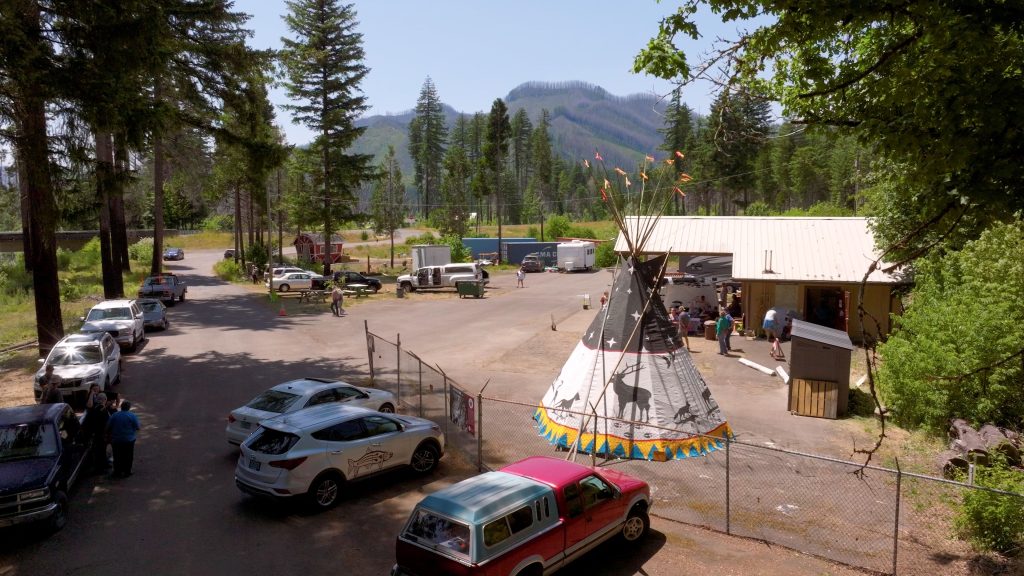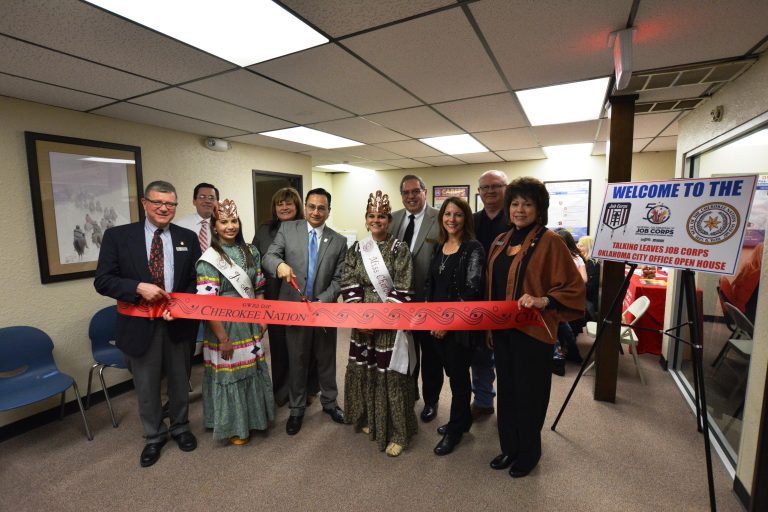Podcast: Play in new window | Download | Embed
(Photo: Michael Sherman)
A new welcome center in the town of Blue River, Oreg. had its grand opening last week.
The McKenzie Crossing and Native Center is located in the geographic “heart” of the nine federally recognized tribes in Oregon. It’s also in an area hit by the 2020 Holiday Farm Fire.
“I wanted to create something up the McKenzie River and Blue River to help it heal.”
Katherine K’iya Wilson is a bicultural liaison for the center, with connections to many tribal communities including Native students she’s mentored at the University of Oregon’s Longhouse.
Although the grand opening competed against other events on June 14 including the “No Kings” rallies, Wilson was pleased at those who made it.
“We had over 50 people there. A wonderful celebration.”

(Photo: Brittany Mason)
The center will show how many tribes crossed through the area for gathering, camping, and traveling to the obsidian cliffs along the coast.
Wilson’s grand plan is to establish a film center for Native people, where they can learn how to make original films.
“At this point I broke the ice, so to speak, and it’s time for the tribes to step in. If they want this to happen I’m here, but it’s too big for this little old lady. But that was the dream.”
Wilson says she’s working with Native grant and business writers to make the film center a reality.

Lake Mead, the nation’s largest man-made lake and reservoir, in April 2025. (Photo: Gabriel Pietrorazio / KJZZ)
President Joe Biden’s Inflation Reduction Act earmarked $320 million to fund the planning and construction of critical water infrastructure projects across Indian Country in consultation with the Bureau of Reclamation.
But as KJZZ’s Gabriel Pietrorazio in the conclusion of his two-part series, it remains unclear how many of those federal dollars – if any – will be clawed back by President Donald Trump.
Uncertainty is rippling from top to bottom, although President Trump just tapped Ted Cooke to be the Commissioner of the Bureau of Reclamation.
Daniel Cordalis (Navajo) runs the Tribal Water Institute at the Native American Rights Fund.
“They’re still building out the political roster at Interior quite a bit.”
Settlements are hugely important legal frameworks for tribes in securing their water rights by basically turning paper claims into guaranteed acre-feet allocations – along with the funding mechanism needed to do so.
Such agreements, largely bipartisan, can only be ratified by Congress.
“And of course, tribal waters are not the president’s priorities. It’s not uncommon. That being said, I think we have an Interior secretary who is sympathetic and supportive of tribes.”
During his confirmation hearing, Interior Secretary Doug Burgum was hopeful he can deliver results for all along the Colorado River.
“I got some good understanding and good exposure to this, but I think you can count on that we’re going to look for a collaborative solution that serves everyone.”
But even if Sec. Burgum is behind tribes, getting the GOP-controlled Congress onboard could still be challenging.
Cordalis says slashing federal dollars may have a trickle-down effect stalling Indian water settlements.
“Congress is very much on the president’s playbook about cutting costs, reducing the budget and doing things and requiring, for lack of a better word, offsets.”

There are 39 federal water settlements with tribes. Here’s where they’re located.(Map: Chelsey Heath and Gabriel Pietrorazio / KJZZ)
The biggest offset of them all would be the Northeastern Arizona Indian Water Rights Settlement for Navajos, Hopis, and San Juan Southern Paiutes. It’s worth $5 billion, an expense that the federal government incurs.
“Where do you offset that and who’s going to do it? That’s the concern here, these settlements have big price tags.”
Cora Tso (Navajo), a senior fellow researching tribal issues at Arizona State University’s Kyl Center for Water Policy, is slightly more optimistic. She thinks the Trump administration sees this settlement for three tribes in northeastern Arizona as an economic driver.
“For the most amount of acres and the largest populations of tribes in the country.”
The first Trump administration ratified the nation’s most expensive Indian water settlement to date – valued at $1.9 billion.
“That tells me, at least from the federal perspective, the first Trump administration understood the investment in Indian water.”
But that all happened before Trump began focusing on so-called government efficiency.
Get National Native News delivered to your inbox daily. Sign up for our daily newsletter today.




Leave a Reply